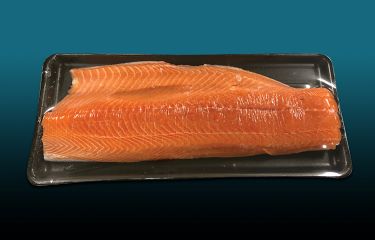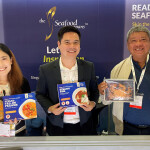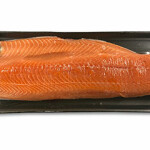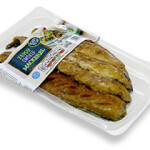Skin-pack dominating the case-ready seafood segment in Europe, US
Sponsored

Seafood has never been known to be among the pioneering proteins in the global case-ready segment. Yet, since its inception, and especially over the past decade, the industry has continued to make a name for itself in the category, according to packaging equipment innovation leader Harpak-ULMA, headquartered in Taunton, Massachusetts, U.S.A.
“The U.S. meat industry has been doing case-ready for years, and the poultry industry has been doing this the same way. The seafood part has just started kicking in,” Harpak-ULMA Product Manager Hugh Crouch told SeafoodSource. “I think some of that was probably driven a lot, pre-Covid. But during Covid, it drove it even more, to the point where we can get fresh seafood everywhere in the nation, now.”
A dearth of seafood counters at retail locations in the U.S., Crouch explained, has amplified the importance of having a case-ready presence in the country.
“In the United States, many places don't have the seafood counter,” Crouch said. “So, you rely on the case-ready part of the business to be the driver for introducing seafood.”
Meanwhile, in Europe, seafood is “very common,” Crouch noted, with larger cities boasting robust seafood counters, staffed by fishmongers and stocked with fresh product on ice.
“As such, case-ready seafood is typically reserved for more rural European areas, but that is shifting slightly,” ULMA Marketing and Communications Manager Aitor Castro Miguelez added. “We usually buy fresh fish in the supermarkets, but also, because of the fast pace of our lives in Europe, we go for case-ready seafood as well.”
“When it comes to case-ready seafood packaging trends in both Europe and the U.S., skin-packaging done in tray-sealing or thermoforming machines currently reigns supreme,” Miguelez said. “The visual appeal and freshness of the product are top priorities for the consumers.”
According to Harpak-ULMA Case Ready Specialist Jay Siers, American consumers specifically have warmed to skin-packed seafood products in the case-ready category faster than they have with other proteins.
“When skin-pack first came out, there was a lot of push-back by the consumer because they said it looks fake. It looks so good; it looks fake. That's not what they're used to. They're used to it looking like fish, beef, or pork. And when you skin-pack something, it's basically a framed picture of that product. It's so pristine if it's done properly. We're seeing skin-packed seafood gaining traction faster than it is with beef and pork,” Siers said.
“Skin-pack also lends itself to a high-end look,” Crouch added. “Consumers have been seeking out these convenient, attractive case-ready seafood products in light of how they've been featured on television. The food networks and cooking shows have really pushed American consumers to ask and reach out for different things.”
Siers noted that skin-packed case-ready seafood appeals to the overarching drive and desire for freshness.
“The single biggest thing, with regards to seafood, is freshness. There's really no second place,” Siers said. “The appearance and perception of freshness are absolutely number one as far as what matters. And I think that's why skin-pack has taken off as well as it has.”
Additionally, case-ready seafood packaging – whether it be skin-packed, stretch over-wrapped, etc. – provides assurances regarding food safety, helps curb waste, and aids in distribution, Siers added.
“Food safety is imperative, and that benefits everybody. But, primarily, it benefits the consumer,” Siers said. “There's far less waste, which benefits the retailer and the consumer. It makes distribution much easier, which benefits the retailer and, ultimately, the consumer because they have access to more variety. It used to be that if you wanted fresh grouper, you had to go to Florida. Well, now you can get grouper that was in the water, in Florida, three days ago, right here in Wichita, Kansas.”
Packaging innovation in the case-ready segment that adheres to increasing sustainability requirements and sentiments will have an edge moving into the future, per Miguelez and Crouch.
“In Europe, we are concerned with sustainability. We have to be very culturally conscious about what kind of packaging and films we use with fish and seafood,” Miguelez said.
Crouch has seen the sustainability part of packaging “really move to the forefront” in Europe. Government regulations are driving this trend, he explained.
“For instance, there are taxes to pay if I'm a European producer utilizing excessive plastic packaging,” Crouch said.
Miguelez believes it’s only a matter of time before double-plastic packaging is phased out in the European market altogether.
“I think that, in the near future, they will say no to double packaging in certain sectors in Europe. They're already moving towards that. We're starting to see it in the produce sector, and we're sure we will see it in other sectors soon,” he said.
Packaging equipment suppliers like Harpak-ULMA provide many innovations to serve this sustainability-forward global marketplace, Miguelez added.
“For thermoforming, flow-packaging, and vertical-bagging for case-ready seafood products, there are already options such as Harpak-ULMA's TFS 200 MSV, FM 300, and VTC 828 R, respectively,” Miguelez explained. “In terms of packaging benefits, horizontal flow packing machines provide a tight seal around the product, preserving freshness and preventing moisture loss. Thermoform packaging allows for customized tray designs and protective sealing, ensuring product integrity and extending shelf life. Vertical bagging can ensure a tight bag for frozen seafood, less material usage, and tighter packs for easy transportation.”








